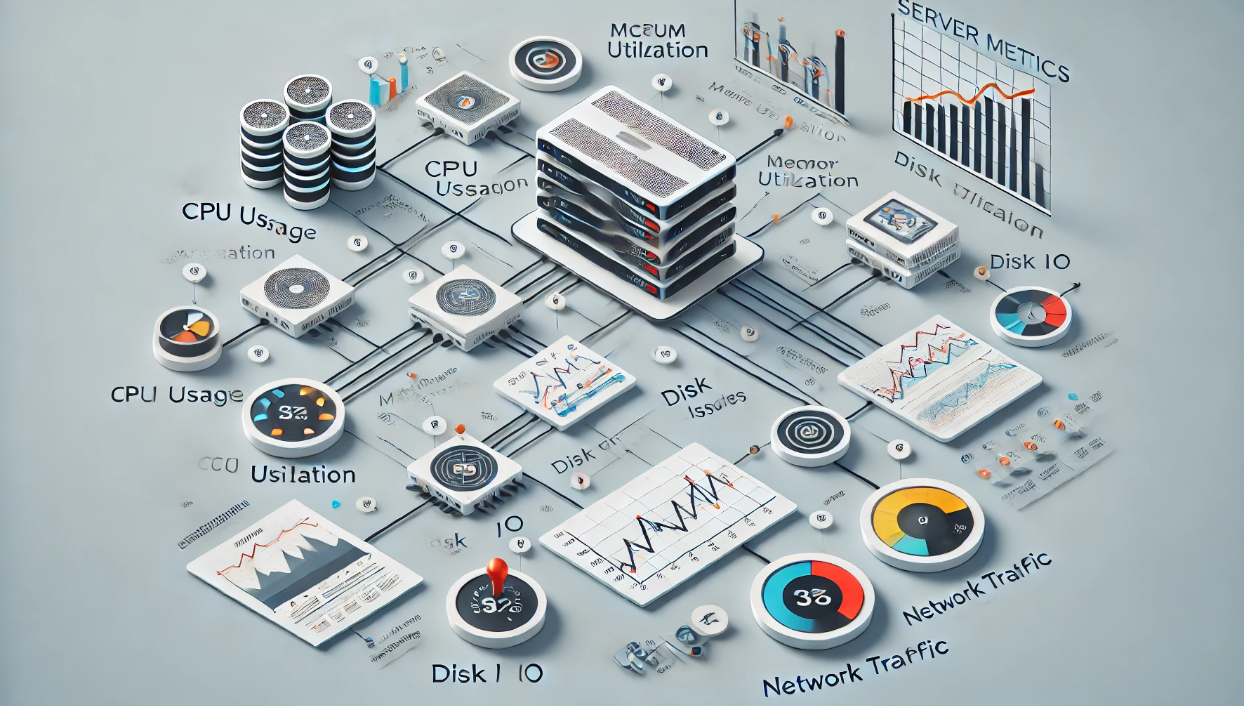️ Top 5 Server Monitoring Tools for Linux: Keep Your Infrastructure in Check
Discover the best tools for monitoring Linux servers, including features, installation steps, and best practices to maintain optimal server performance.
Why Server Monitoring Matters
Monitoring your Linux servers is essential for ensuring performance, identifying potential issues early, and preventing costly downtime.
Server monitoring tools help track CPU usage, memory consumption, disk activity, network performance, and security metrics.
⚠️ 1. Detect Performance Issues Early
Monitoring tools provide real-time insights into CPU spikes, memory leaks, and network congestion, helping you prevent crashes.
2. Improve Server Security
Monitoring tools can detect suspicious activities—like unexpected login attempts or anomalous network traffic—helping mitigate security risks.
3. Optimize Resource Usage
Monitoring helps track resource utilization trends, identify bottlenecks, and scale infrastructure efficiently.
️ Top 5 Server Monitoring Tools for Linux
1️⃣ Prometheus (Open-Source Monitoring & Alerting)
Prometheus is a powerful open-source monitoring solution designed for cloud-native applications. It collects metrics using exporters and visualizes data with Grafana dashboards.
Key Features:
- Time-series database for metrics collection
- ⚙️ Flexible query language (PromQL)
- Built-in alert manager for custom notifications
- Seamless integration with Kubernetes
✅ Pros:
- Free & open-source
- ⚡ Highly scalable for cloud environments
- Excellent integration with Grafana and Docker
❌ Cons:
- ️ Steep learning curve
- High storage demands for long-term metrics
Best For: Cloud-native infrastructures and DevOps teams.
Installation Command:
# Download Prometheus
curl -LO https://github.com/prometheus/prometheus/releases/download/v2.50.0/prometheus-2.50.0.linux-amd64.tar.gz
# Extract and start
tar xvf prometheus-2.50.0.linux-amd64.tar.gz
cd prometheus-2.50.0.linux-amd64
./prometheus --config.file=prometheus.yml
2️⃣ Zabbix (Enterprise-Grade Monitoring)
Zabbix is a comprehensive monitoring tool with real-time performance tracking, alerting, and trend analysis.
Key Features:
- Agent-based and agentless monitoring
- Web-based dashboard
- Advanced notification system (email, SMS, Slack)
- ️ Built-in templates for services like MySQL and Apache
✅ Pros:
- Free and open-source
- Customizable dashboards
- Supports auto-discovery
❌ Cons:
- Resource-heavy for large deployments
- ⚙️ Complex initial configuration
Best For: SMBs, enterprises, and hybrid clouds.
Installation Command (Ubuntu/Debian):
# Add Zabbix repository
sudo apt update
sudo apt install zabbix-server-mysql zabbix-frontend-php zabbix-apache-conf zabbix-agent
# Start Zabbix services
sudo systemctl restart zabbix-server zabbix-agent apache2
3️⃣ Nagios Core (Legacy Monitoring Powerhouse)
Nagios Core is a widely used monitoring tool known for its extensibility through plugins.
Key Features:
- Comprehensive infrastructure monitoring
- Customizable alerts for various incidents
- ⚙️ Community plugins for extended functionality
- Historical data reports
✅ Pros:
- Free (Nagios Core)
- ️ Lightweight for basic setups
- Active community support
❌ Cons:
- ️ Outdated web interface
- Manual configuration via text files
Best For: Small to medium-sized businesses.
Installation Command:
# Install Nagios Core
sudo apt update
sudo apt install nagios4 nagios-plugins-all -y
# Start Nagios service
sudo systemctl start nagios4
4️⃣ Datadog (Cloud-Native Monitoring & Security)
Datadog is a SaaS-based monitoring platform with infrastructure monitoring, log management, and security features.
Key Features:
- Unified dashboard for infrastructure, applications, and logs
- Agent-based monitoring with auto-discovery
- AI-powered anomaly detection
- Mobile app for on-the-go monitoring
✅ Pros:
- ⚡ Intuitive interface and easy setup
- Advanced analytics and visualization
- Built-in security features
❌ Cons:
- Paid service (free trial available)
- Complex pricing structure
Best For: Cloud environments and DevOps teams.
Installation Command:
# Install Datadog agent DD_API_KEY=bash -c "$(curl -L https://s3.amazonaws.com/dd-agent/scripts/install_script.sh)"
5️⃣ Netdata (Real-Time Monitoring Made Simple)
Netdata is a lightweight monitoring tool designed for real-time performance tracking with an interactive web interface.
Key Features:
- ⚡ Minimal performance impact
- ️ Interactive charts with per-second updates
- Auto-discovery of services and applications
- Cloud-based dashboard
✅ Pros:
- Free and open-source
- ️ Easy installation and user-friendly interface
- Real-time monitoring
❌ Cons:
- Limited historical data retention
- ⚙️ Less suited for large-scale infrastructure
Best For: Small to medium-sized environments.
Installation Command:
# Install Netdata
bash <(curl -Ss https://my-netdata.io/kickstart.sh)
Feature Comparison Chart
| Feature | Prometheus | Zabbix | Nagios Core | Datadog | Netdata |
|---|---|---|---|---|---|
| License | Open-source | Open-source | Open-source | Commercial | Open-source |
| UI/UX | Complex | User-friendly | Outdated | Modern | Simple |
| Cloud Integration | Yes | Yes | Partial | Yes | Yes |
| Alerting | Built-in | Advanced | Basic | AI-based | Basic |
| Best For | Cloud-native apps | Enterprises | SMBs | DevOps teams | Developers |
| Learning Curve | Steep | Moderate | Easy | Moderate | Easy |
Key Metrics to Track for Linux Server Monitoring
- ⚙️ CPU Usage (spikes may indicate inefficient applications)
- Memory Utilization (high usage can cause slowdowns)
- ️ Disk Usage & I/O (excessive I/O may signal database issues)
- Network Traffic (monitor for unusual spikes indicating DDoS attacks)
- Security Logs (track login attempts and suspicious behavior)
Server Monitoring Best Practices
- ✅ Automate alerts for critical metrics
- Regularly review logs using tools like Logwatch or ELK
- ️ Update monitoring software regularly
- Use multiple tools for comprehensive coverage
Conclusion: Stay Proactive with Linux Server Monitoring
Proactive monitoring ensures your Linux infrastructure runs smoothly and securely.
With real-time insights, customizable alerts, and data visualization tools, you can detect issues early, optimize performance, and protect your servers.
Key Takeaways:
- ️ Prometheus: Best for cloud-native applications
- Zabbix: Ideal for enterprise-grade infrastructure
- ⚙️ Nagios Core: Great for basic monitoring needs
- Datadog: Perfect for modern cloud environments
- Netdata: Lightweight and real-time insights

